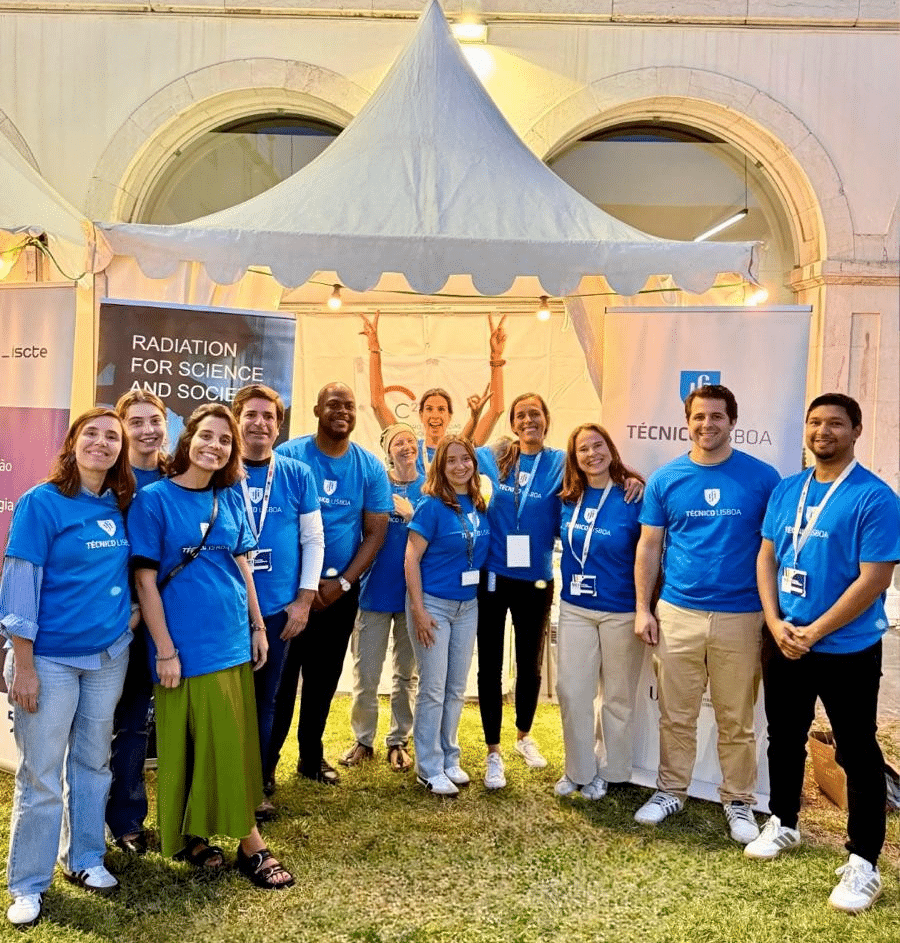From levitation to irradiated strawberries, researchers and students from Instituto Superior Técnico showed how fascinating, fun and accessible science can be. European Researchers’ Night brought together science, curiosity and good humour, proving that radiation can also be synonymous with sustainability and health.
Science left the laboratories and went out to meet citizens in the latest edition of European Researchers’ Night (ERN), which took place on 26th September in several cities across the country. In Lisbon, the Centro de Ciências e Tecnologias Nucleares (C2TN) of Instituto Superior Técnico was present at Museu Nacional de História Natural e da Ciência (MUHNAC), with the theme ‘Radiation for Global Challenges’, transforming scientific knowledge into interactive experiences, laughter and many discoveries.
Throughout the night, researchers and students from C2TN invited the public to explore the role of radiation and nuclear sciences in health, the environment and sustainability. Young and old alike had the opportunity to levitate magnets, taste irradiated strawberries, find out if their jewellery was fake, understand how the air we breathe affects sleep and health, and even take a close look at the natural radioactivity present in old Portuguese mines. The activities showed how science contributes to addressing global challenges, from air quality to natural resource management, always with the public at the centre of the experience.
Among the most popular demonstrations was that of Vital Filho, a PhD student, who showed how a superconductor can levitate magnetic materials such as magnets through the phenomenon of magnetic levitation. ‘It’s a fun way to show how physics is one of the foundations for future technologies, from more efficient transport to medical equipment,’ explained the student, surrounded by wide-eyed children.
Chemistry also shone with researcher Dulce Belo, who delighted younger audiences with the activity ‘Dance of the Elements: The Magic of Molecules!’. Amidst small colourful reactions, the children discovered that ‘building molecules is like putting together a puzzle’ and that curiosity can be the best spark to awaken future scientists. ‘Showing that chemical reactions are safe and fascinating is essential to bring science closer to everyday life,’ emphasised the researcher.
Health was highlighted by the Radiopharmaceutical Sciences Group, represented by PhD student Joana Santos and research fellow Juliana Martins, who explained how radiopharmacy contributes to the fight against cancer. Through a game with coloured cubes, the audience was able to see the various stages of radiopharmaceutical development, observe cancer cells under a microscope and understand how research can save lives. ‘We want to show that radiation also heals,’ said Joana Santos and Juliana Martins.
In the environmental field, the ObservAR Group — with researchers Marta Almeida and Tiago Faria, PhD students Alexandra Nunes and Sérgio Mendez, Master’s student Sérgio Bartolomeu and research fellow Vinicius Leite — presented projects dedicated to air quality and sustainability, highlighting the role of science in mitigating air pollution and promoting public health. ‘Participating in the initiative is always an enriching experience that allows us to share projects of great scientific and social relevance and inspire new generations towards knowledge and sustainability,’ said Tiago Faria, referring to the European projects ‘ECF4CLIM’, ´InChildHealth` and ‘MI-TRAP’. For Alexandra Nunes, who presented the ‘iMPact’ project, ‘participating in ERN was an opportunity to bring science to the people and raise awareness of the environmental challenges that affect the health of us all.’ Vinicius Silveira Leite, involved in the ´ODESSA` project, emphasised ‘the importance of communicating science and inspiring younger generations.’ Sérgio Mendez, with the ´HypnosAir` project, highlighted “the relationship between air quality and sleep”, inviting the public to participate in the 1st National Study on Sleep Quality and reinforcing “the importance of understanding how the environment influences health”.
The activity ‘Fake or not Fake’, led by researchers Susana Gomes and Victoria Corregidor Berdasco and technician Pedro Valério, revealed the composition of rings and earrings using the X-ray fluorescence (XRF) technique. ‘You have to know something to appreciate it — and nuclear sciences play a fundamental role in cultural heritage research,’ emphasised Pedro Valério. “Returning to ERN was like reliving my college days and, at the same time, revealing to young people and children the mysteries of the metal alloys we use every day. An incredible experience,” summarised Susana Gomes.
Technician Yuri Romanets and researcher Salvatore Di Maria took visitors on a journey through the history of Portuguese mining with their demonstration entitled ‘Natural Radioactivity’, using ionisation chambers to show how old uranium mines continue to leave their mark on the soil and vegetation. ‘It’s a way of understanding the past and reflecting on the environmental impact of our choices,’ explained Salvatore Di Maria. ‘European Researchers’ Night is a unique opportunity to show how science is part of our daily lives. It is also a space for sharing, where different areas of knowledge and innovation come together and become accessible to everyone’, emphasised Yuri Romanets.
And because science can also be savoured, the now famous ‘Blind Strawberry Tasting’ once again surprised the public. Researchers Sandra Cabo Verde and Joana Madureira challenged visitors to taste strawberries treated with ionising radiation — and the verdict was unanimous: the taste is the same. ‘Radiation can be an ally of sustainability by reducing food waste without resorting to chemicals,’ said Sandra Cabo Verde, adding that ‘these experiments help to break down fears and reinforce confidence in science’.
With the slogan ‘Science for Global Challenges,’ European Researchers’ Night reaffirmed the importance of bringing scientific knowledge closer to society.

